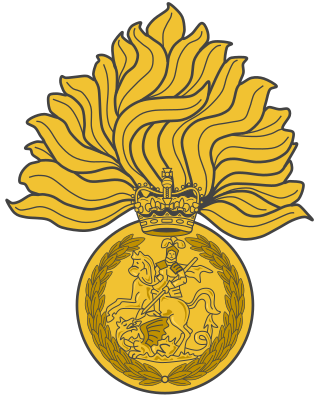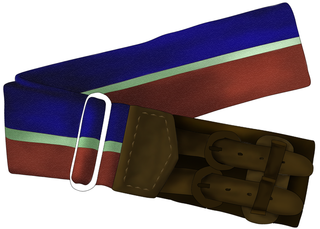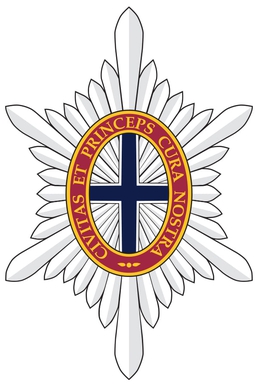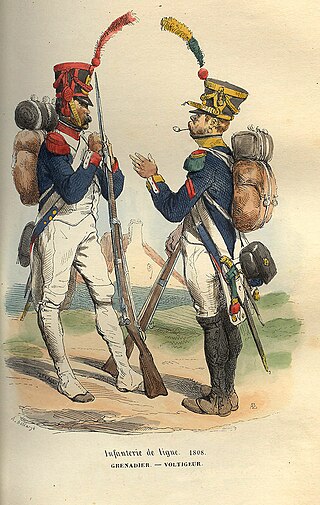
The Regulation Colours are the standard colours used in the armed forces of the countries of the Commonwealth of Nations.

The Regulation Colours are the standard colours used in the armed forces of the countries of the Commonwealth of Nations.
British Armed Forces units usually carry two Regulation Colours: the Regulation King's Colour and Regulation Regimental Colour. These are often referred to as the standard or ensign.
Colours are the identifying battle flags carried by military regiments to show where their respective soldiers should rally in battle. Originally these were 6 feet 6 inches (198 cm) × 6 feet (183 cm) in size, though have now been reduced to 3 feet 9 inches (114 cm) × 3 feet (91 cm), as regiments no longer carry their colours on the battlefield.
Prior to 1743, each infantry regiment of the British Army was responsible for the design and quantity of standards carried, often with each company having its own design. In that year King George II issued a royal warrant to require each regiment to have, as their first colour, the King's colour. It was also to consist of the Union Jack throughout, as a symbol of royal allegiance[ citation needed ]. The second colour was to be the colour of the facings (uniform linings) of each regiment, with the Union flag in the upper canton. When regiments had red or white facings, this was to be replaced by the red cross of St George on a white background. Regiments with "Royal" designation or named after the members of the royal family, regardless of facings, used royal blue regimental colours (plus the optional Union Jack canton), Irish regiments green facings.
A second royal warrant was issued in 1747, requiring the regimental number to be displayed on the colours. As many regiments at that time were known by the name of the regimental colonel instead of a number, this requirement was often ignored. On 1 July 1751 a third royal warrant was issued stating "No Colonel is to put his Arms, Crest, Device, or Livery on any part of the Appointments of the Regiment under his Command." Company colours were phased out altogether, with the battalion colours of the regiment using the designs issued being the only sanctioned ones used.
Over time, these colours have evolved to include the battle honours awarded to each regiment, though these have also been limited.
The last British Army regiment to carry its regimental colours into battle was the 58th (Rutlandshire) Regiment of Foot in January 1881 at the Battle of Laing's Nek during the First Boer War. [1]

Only one British regiment carries more than two colours on parade. This is the Yorkshire Regiment, who carry four colours. The second pair consists of a stand of honorary battle flags, which are the original size of 6 ft 6 in × 6 ft. These honorary colours, 'King's Honorary Colour' and 'Regimental Honorary Colour,' were originally awarded to the 76th Regiment of Foot, which later became the 2nd Battalion of the Duke of Wellington's (West Riding Regiment) in 1808, by the Honorable East India Company for their distinguished services during the Battle of Ally Ghur and again at Delhi between 1802 and 1804. [2] In 1948 the 1st and 2nd Battalions merged and retained the Honorary Colours. In 2006 the Duke of Wellington's Regiment merged with the Prince of Wales's Own Regiment of Yorkshire and the Green Howards to form the 'Yorkshire Regiment (14th/15th, 19th and 33rd/76th Foot)'. [3]
Rifle regiments (today The Rifles) plus the Brigade of Gurkhas do not use colours at all owing to their role. The latter, however, carries the Queen's Truncheon awarded in 1857 instead.
Unlike the rest of the Army, all five Foot Guards infantry regiments sport a different variant pattern.
Given the status of the guards regiments as units under royal patronage and for the defence of the British Royal Family and facilities belonging to them, the design of the colours are:
Unlike most infantry regiments, all five carry all battle honours on both colours.
Until the 1820s, the Guards infantry carried company colours alongside the regimental battalion colours.
A third colour, the Guards State Colour, is unique to the Grenadier, Coldstream, and Scots Guards, and only used when the monarch is present. Their design is scarlet with the regimental insignia and arms at the centre with the Royal Cypher at the corners. No battle honours are present.

In military organizations, a colour guard is a detachment of soldiers assigned to the protection of regimental colours and the national flag. This duty is highly prestigious, and the military colour is generally carried by a young officer (ensign), while experienced non-commissioned officers are assigned to the protection of the national flag. These non-commissioned officers, accompanied in several countries by warrant officers, can be ceremonially armed with either sabres or rifles to protect the colour. Colour guards are generally dismounted, but there are also mounted colour guard formations as well.

The Royal Regiment of Fusiliers is an infantry regiment of the British Army, part of the Queen's Division. Currently, the regiment has two battalions: the 1st Battalion, part of the Regular Army, is an armoured infantry battalion based in Tidworth, Wiltshire, and the 5th Battalion, part of the Army Reserve, recruits in the traditional fusilier recruiting areas across England. The Royal Regiment of Fusiliers was largely unaffected by the infantry reforms that were announced in December 2004, but under the Army 2020 reduction in the size of the Army, the 2nd Battalion was merged into the first in 2014.

Colour sergeant is a rank of non-commissioned officer found in several armies and marine corps.

A stable belt is a striped coloured belt worn at times by the armed forces of the United Kingdom, other Commonwealth countries, and a few other countries including Denmark, Brazil and Lebanon. The stripes vary by regiment and corps, identifying the wearer's unit. In Brazil and Lebanon they are known as gymnastic belts.

"Other ranks" is the term used to refer to all ranks below officers in the British Army and the Royal Marines. It includes warrant officers, non-commissioned officers ("NCOs") and ordinary soldiers with the rank of private or regimental equivalent. Officers may, in speaking, distinguish themselves from those "in the ranks".

The Governor General's Foot Guards (GGFG) is the senior reserve infantry regiment in the Canadian Army. Located in Ottawa at the Cartier Square Drill Hall, the regiment is a Primary Reserve infantry unit, and the members are part-time soldiers.

In military organizations, the practice of carrying colours, standards, flags, or guidons, both to act as a rallying point for troops and to mark the location of the commander, is thought to have originated in Ancient Egypt some 5,000 years ago. The Roman Empire also made battle standards reading SPQR a part of their vast armies. It was formalized in the armies of Europe in the High Middle Ages, with standards being emblazoned with the commander's coat of arms.

The following is a list of historical military colours, standards and guidons in different countries that do not exist today.

The Somerset Light Infantry (Prince Albert's) was a light infantry regiment of the British Army, which served under various titles from 1685 to 1959. In 1959, the regiment was amalgamated with the Duke of Cornwall's Light Infantry to form the Somerset and Cornwall Light Infantry which was again amalgamated, in 1968, with the King's Own Yorkshire Light Infantry, the King's Shropshire Light Infantry and the Durham Light Infantry to form The Light Infantry. In 2007, however, The Light Infantry was amalgamated further with the Devonshire and Dorset Regiment, the Royal Gloucestershire, Berkshire and Wiltshire Regiment and the Royal Green Jackets to form The Rifles.

The Green Howards , frequently known as the Yorkshire Regiment until the 1920s, was a line infantry regiment of the British Army, in the King's Division. Raised in 1688, it served under various titles until it was amalgamated with the Prince of Wales's Own Regiment of Yorkshire and the Duke of Wellington's Regiment, all Yorkshire-based regiments in the King's Division, to form the Yorkshire Regiment on 6 June 2006.

The Buffs (Royal East Kent Regiment), formerly the 3rd Regiment of Foot, was a line infantry regiment of the British Army traditionally raised in the English county of Kent and garrisoned at Canterbury. It had a history dating back to 1572 and was one of the oldest regiments in the British Army, being third in order of precedence (ranked as the 3rd Regiment of the line). The regiment provided distinguished service over a period of almost four hundred years accumulating one hundred and sixteen battle honours. In 1881, under the Childers Reforms, it was known as the Buffs (East Kent Regiment) and later, on 3 June 1935, was renamed the Buffs (Royal East Kent Regiment).

A battle honour is an award of a right by a government or sovereign to a military unit to emblazon the name of a battle or operation on its flags ("colours"), uniforms or other accessories where ornamentation is possible.

The Royal Montreal Regiment is a Primary Reserve infantry regiment of the Canadian Army based in Westmount, Quebec. It is part of the 2nd Canadian Division's 34 Canadian Brigade Group.

A facing colour is a common tailoring technique for European military uniforms where the visible inside lining of a standard military jacket, coat or tunic is of a different colour to that of the garment itself. The jacket lining evolved to be of different coloured material, then of specific hues. Accordingly, when the material was turned back on itself: the cuffs, lapels and tails of the jacket exposed the contrasting colours of the lining or facings, enabling ready visual distinction of different units: regiments, divisions or battalions each with their own specific and prominent colours. The use of distinctive facings for individual regiments was at its most popular in 18th century armies, but standardisation within infantry branches became more common during and after the Napoleonic Wars.
The Childers Reforms of 1881 reorganised the infantry regiments of the British Army. The reforms were done by Secretary of State for War Hugh Childers during 1881, and were a continuation of the earlier Cardwell Reforms.

The uniforms of the British Army currently exist in twelve categories ranging from ceremonial uniforms to combat dress. Uniforms in the British Army are specific to the regiment to which a soldier belongs. Full dress presents the most differentiation between units, and there are fewer regimental distinctions between ceremonial dress, service dress, barrack dress and combat dress, though a level of regimental distinction runs throughout.

The following battle honours were awarded to units of the British Army and the armies of British India and the Dominions of the British Empire. From their institution until the end of the Second World War, awards were made by, or in consultation with, the British government, but, since 1945, the individual countries of the former British Empire have awarded battle honours to their forces independently.

The President's Colour Award is the highest honour that can be bestowed upon any military unit of India. It is also known as Nishaan, which is an emblem that is worn by all unit officers on the left-hand sleeve of their uniform.